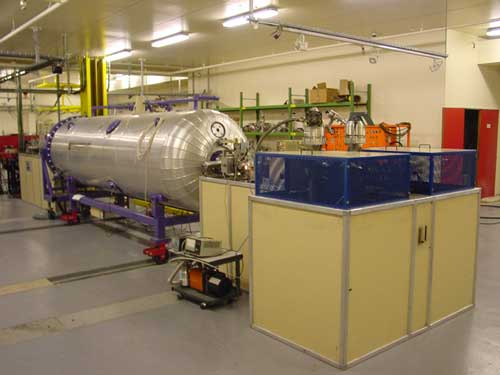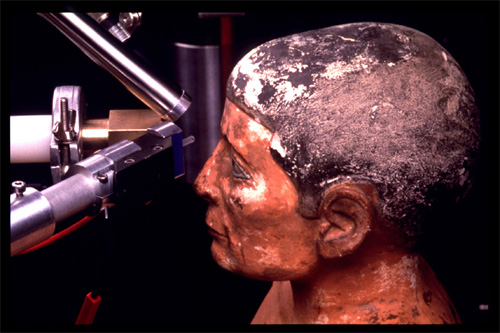A modern tool for the analysis of works of art
Why use an accelerator to analyze the composition of an ancient object and deduce its origin, authenticity, location and date of manufacture? This type of heavy equipment may seem incongruous in a museum.

AGLAE
General view of the AGLAE accelerator of the Laboratoire de Recherche des Musées de France in the basement of the Louvre Museum.
© LRMF
This type of accelerator accelerates light particles, mostly protons, but also deuterium nuclei or alpha particles at energies of a few million electronvolts. These particles are similar to those emitted by radioactive sources, but the accelerator allows to choose at will their number and energy.
The advantage of these “Ion beam analysis” is to direct the particles on the object to be analyzed. Guided with precision, the “beams” of accelerated particles (Accelerator technicians call “beam” the accelerated particles). The beams of electrically charged particles can be accelerated, focused and directed. struck a detail of the target to study. These accelerated particles penetrate little in the target, only probing its surface.
Along their short path, these light nuclei disturb the electron cloud of a large number of atoms or initiate nuclear reactions with light elements, as do the alpha radioactive sources. The highly sensitive technique of the Rutherford backscattering (RBS) is based on the measurement of particles that bounce back (they are said to backscatter) as a result of collisions with heavy nuclei

A scribe eye examination ?
This Egyptian scribe undergo an ophthalmological survey. His eye is positioned opposite to the exit window of the AGLAE beam. The horizontal tube is the beam one; the other two are used for X-rays detection. A air beam extraction is achieved through an ultra-thin but strong window of 0.1-micron made of silicon nitride, allows working at atmospheric pressure. One obtains a beam diameter of about 2 microns by placing the object at 3 mm from the window.
© Dominique BAGAULT/LRMF
Atoms perturbed by the passage of the beam particles emit characteristic radiation whose observation “sign” unambiguously the presence, even in trace amounts of a given atom. These rays consist of photons, having an energy characteristics of the atom. One detects only those that are penetrating enough to exit from the target, such as the X-rays emitted from the deeper layer of the atom. It is the PIXE method. It is extremely sensitive to measure very low concentrations of chemical elements with atomic number Z> 10 (as sodium).
A third method used comparatively less often, the PIGE method, concerns light nuclei with which the particle beam can produce nuclear reactions. Gamma rays are issued, characteristics of the target nucleus.
These methods of analysis by particle beams combine very high sensitivity to harmlessness for artworks. These advantages have led, in the late 1980s to provide the Research Laboratory of the Museums of France (LRMF) with the AGLAE (Accelerator Grand Louvre d’Analyse Elementaire) facility. Commissioned in 1989, AGLAE has long been the only facility of its kind in the world to be implanted in a museum laboratory. It celebrated its 20th anniversary in 2009.
AGLAE is an electrostatic “tandem” accelerator of 2 million-volt, equipped with ion sources, allowing production of protons, deuterons, and alpha particles beams.
A decisive improvement was the ability to extract the beam from the vacuum tube through a window sufficiently strong to withstand atmospheric pressure and the damage induced by the beam, but thin enough to minimize the loss of energy and angular dispersion of particles. The artwork can then be freely placed at very short distance (a few mm downstream of this window). For RBS analysis, sweeping up the surface of the object by a flow of helium improves the quality of measurements by reducing the collisions of ions with the oxygen and nitrogen nuclei from the air.
Apart from the obvious ease of operation in air, the main advantages offered by an external beam extracted are: the ability to manipulate objects of any size and shape; the possibility to analyse fragile objects that may suffer from an implementation under vacuum, a significant reduction in thermal effects of the beam. Nevertheless, the analysis is limited to the surface area of the material (up to several tens of micrometers). It gives no information on the chemical state of elements.
NEW AGLAE, an improved update of the installation has been inaugurated in november 2017, and started to take data early in 2018.
DOCUMENT : Nov 2017, BBC : World’s only particle accelerator for art is back at the Louvre